From the Trenches
Medieval Russian Memo
By ERIC A. POWELL
Tuesday, February 16, 2016

During excavation of a medieval road near the Kremlin in Moscow, Russian archaeologists recently unearthed a birchbark letter dating to the fourteenth or fifteenth century. It was probably written by a servant to his master, and describes unforeseen travel expenses he incurred on an ill-fated trip to the city of Kostroma, about 200 miles to the northeast. According to the text, somewhere along the journey he was stopped by someone named “Yuri,” possibly an administrator, who fined the hapless servant twice. The letter reports that Yuri helped himself to 36 belas, a unit of currency at the time. “It is probably about a debt collection or an unpaid custom duty,” says Leonid Belyaev of the Russian Academy of Sciences’ Institute of Archaeology, who is supervising the dig. “Or maybe just extortion.” This is only the fourth medieval birchbark text to have been discovered in Moscow. The other three are drafts of legal documents.
A Circle of Skulls
By ROGER ATWOOD
Tuesday, February 16, 2016
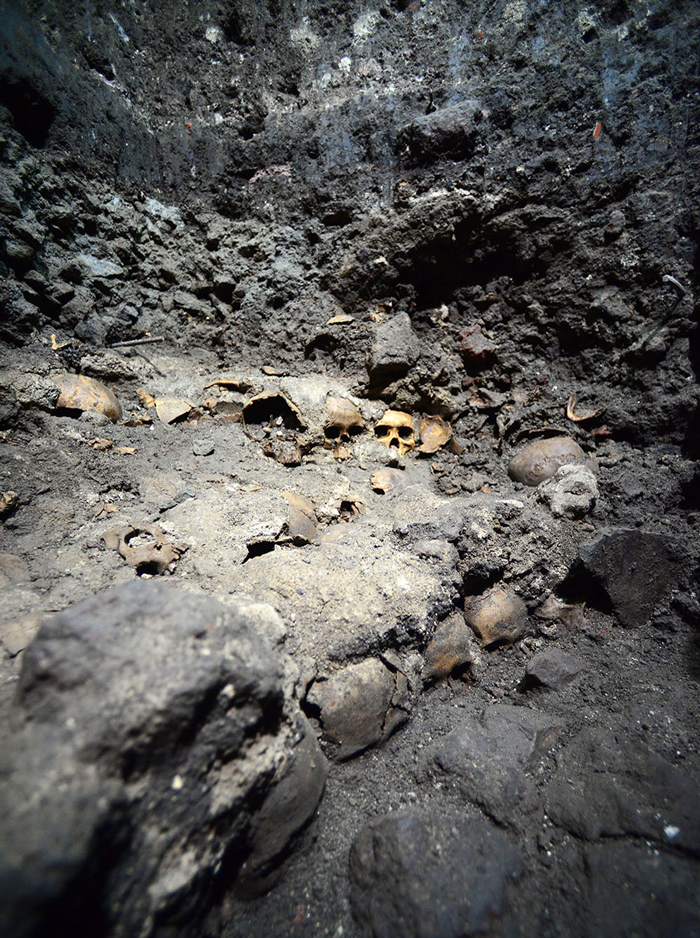 The Aztecs did creative things with severed heads. Archaeologists at Mexico City’s Aztec temple complex have found 35 human skulls mortared together with a mix of sand, limestone, and volcanic rock. Dating from about A.D. 1500, during a late Aztec building boom, the skulls were embedded in a circular inner wall on a ceremonial platform. Unusually, all the skulls were positioned facing the center of the platform, not toward the outside. The Aztecs were known to display heads—facing outward—on horizontal spits known as tzompantli to demonstrate the power of their state, whose capital, Tenochtitlán, lies under the streets of modern-day Mexico City. Almost all the skulls in the wall belonged to young men, suggesting they were captives from wars against neighboring states, says Raúl Barrera, lead archaeologist at the site. The discovery didn’t come as a total surprise; Spanish chroniclers had described the grisly sight in their sixteenth-century accounts of the ancient capital. “We have found the uppermost level of the wall,” says Barrera. “It’s quite likely we’ll find more heads at lower levels.” The exact function of the ceremonial platform is not known, according to Barrera, but it was elaborately constructed with flagstones, volcanic bricks, stucco—and more human bones embedded in its outer walls.
The Aztecs did creative things with severed heads. Archaeologists at Mexico City’s Aztec temple complex have found 35 human skulls mortared together with a mix of sand, limestone, and volcanic rock. Dating from about A.D. 1500, during a late Aztec building boom, the skulls were embedded in a circular inner wall on a ceremonial platform. Unusually, all the skulls were positioned facing the center of the platform, not toward the outside. The Aztecs were known to display heads—facing outward—on horizontal spits known as tzompantli to demonstrate the power of their state, whose capital, Tenochtitlán, lies under the streets of modern-day Mexico City. Almost all the skulls in the wall belonged to young men, suggesting they were captives from wars against neighboring states, says Raúl Barrera, lead archaeologist at the site. The discovery didn’t come as a total surprise; Spanish chroniclers had described the grisly sight in their sixteenth-century accounts of the ancient capital. “We have found the uppermost level of the wall,” says Barrera. “It’s quite likely we’ll find more heads at lower levels.” The exact function of the ceremonial platform is not known, according to Barrera, but it was elaborately constructed with flagstones, volcanic bricks, stucco—and more human bones embedded in its outer walls.
Legends of Glastonbury Abbey
By JASON URBANUS
Tuesday, February 16, 2016
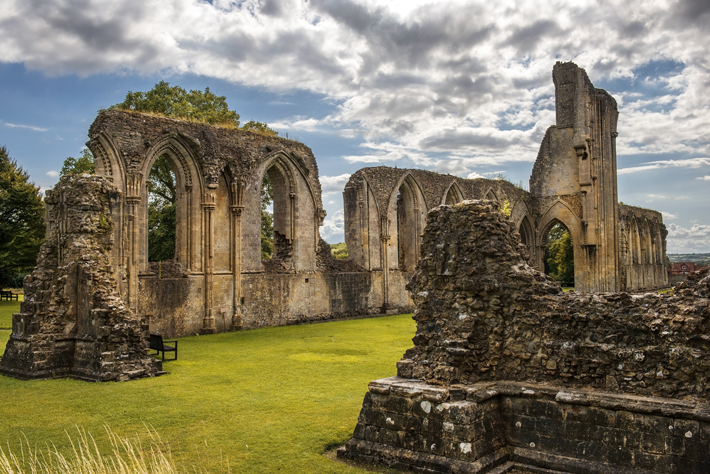
Although today it stands in ruins, Glastonbury Abbey, in Somerset, England, is still a powerfully evocative place, shrouded in history, religion, and mythology. One story claims that Joseph of Arimathea, legendary keeper of the Holy Grail, founded the first Christian church in Britain at Glastonbury shortly after the death of Christ. Another holds that in 1191, monks from the abbey unearthed a hollowed-out log containing two bodies and an inscribed cross that read: “Here lies buried King Arthur and his wife Guinevere.”
The traditions and myths surrounding Glastonbury Abbey are perhaps key among the reasons it developed into one of the most important—and wealthiest—monasteries in Europe. But skeptics have long decried these stories as inventions by medieval monks to fill the abbey’s coffers, especially after a massive fire destroyed the monastery in 1184. Archaeologist Roberta Gilchrist of the University of Reading has recently completed a multiyear project aimed at constructing a new history of Glastonbury Abbey, unencumbered by previous assumptions based solely on myth. “Glastonbury Abbey holds a unique place in the history of medieval monasticism and in the development of English cultural identity,” says Gilchrist. “Yet despite its historical and cultural significance, relatively little was known about the abbey’s archaeology.”
Most of the Glastonbury Abbey Project’s efforts were focused on reevaluating data from previous excavations. From 1904 to 1979, at least 36 excavations were completed, but much of that material was lost or never published. It has also been frequently misinterpreted. Gilchrist and her team have spent several years combing through a century’s worth of archives, as well as conducting new radiocarbon dating and chemical composition analysis on previously excavated artifacts. “Our goals were to assess the scholarly significance of the excavations and provide a new historical source of evidence for understanding the site,” says Gilchrist.
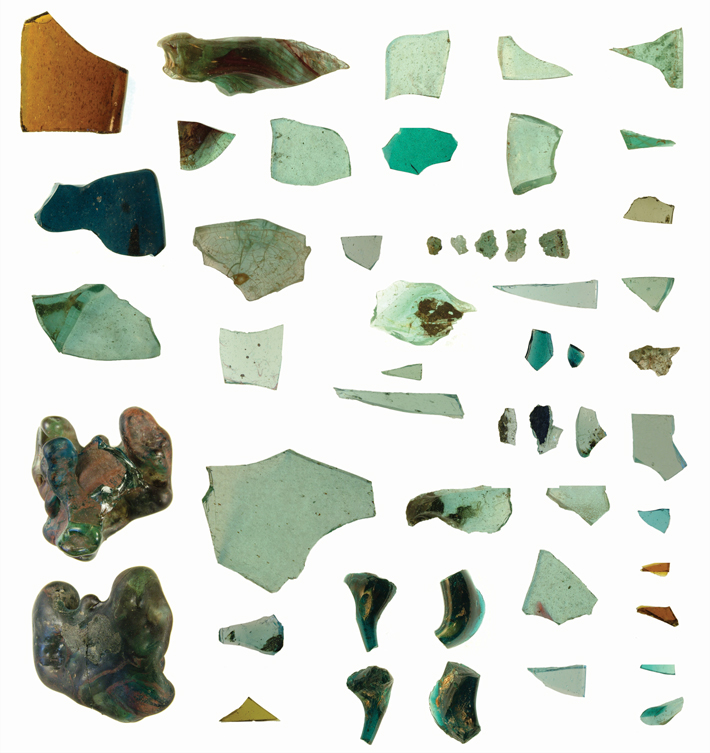 The project’s discoveries underscore Glastonbury’s long and complex history, including newly identified evidence of Roman and Saxon activity that predates the abbey’s foundation. A reassessment of glass-producing furnaces on the site proved not only that Saxon workers were recycling Roman glass imported from Europe, but also that the furnaces are nearly 300 years older than expected and are associated with the construction of the first stone churches around A.D. 700. According to Gilchrist, this would make the site’s glass manufacturing complex among the earliest and most substantial in Saxon England.
The project’s discoveries underscore Glastonbury’s long and complex history, including newly identified evidence of Roman and Saxon activity that predates the abbey’s foundation. A reassessment of glass-producing furnaces on the site proved not only that Saxon workers were recycling Roman glass imported from Europe, but also that the furnaces are nearly 300 years older than expected and are associated with the construction of the first stone churches around A.D. 700. According to Gilchrist, this would make the site’s glass manufacturing complex among the earliest and most substantial in Saxon England.
Researchers also reevaluated the purported site of King Arthur’s grave. Both the skeletal remains and the inscribed cross disappeared after the dissolution of the abbey in 1539, but archaeologist Ralegh Radford claimed to have found the original burial site when he excavated at Glastonbury during the 1950s and 1960s. Unfortunately, there is little proof connecting that site with the famous king. “Radford may have exaggerated his evidence,” says Gilchrist. “Reassessment of his excavation records shows that this was merely a pit in a cemetery, dating to sometime between the eleventh and fifteenth centuries.”
Analysis of the twelfth-century abbey church indicates that the monks themselves purposefully promoted the site’s historic reputation. As they rebuilt the church after the great fire in 1184, instead of using contemporary architectural styles, they inserted antiquated and retrospective elements, apparently to deliberately feign antiquity.
There is no doubt that many of the myths surrounding Glastonbury Abbey were at least partially created or propagated in both medieval and modern times. However, according to Gilchrist, too much media attention has focused on the new evidence that seems to refute Glastonbury’s mythical traditions. For her, there is room for both archaeology and legend to coexist. “At Glastonbury, people respond on a personal level to the place and its historical, legendary, and spiritual resonances. We didn’t claim to disprove the legendary associations, nor would we wish to,” she says. “Archaeology can help us to understand how legends evolve and what people in the past believed.” In fact, she notes, the project has actually uncovered the first definitive proof of occupation at the Glastonbury Abbey site during the fifth century—when Arthur allegedly lived.
Off the Grid
By MALIN GRUNBERG BANYASZ
Tuesday, February 16, 2016
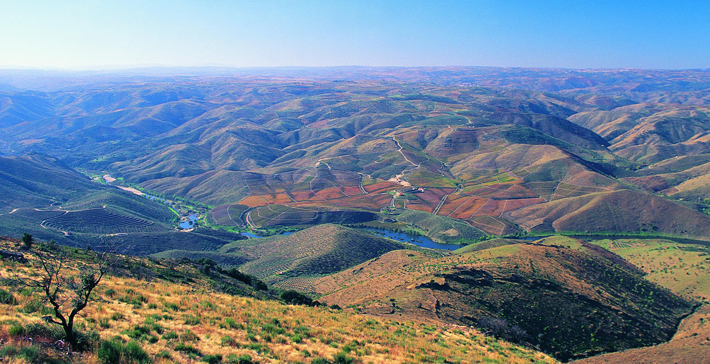
As with many archaeological sites, the Côa Valley in northeastern Portugal came to the attention of authorities because of a dam. An energy company commissioned an archaeological survey prior to beginning construction, which led to the discovery of one of Europe’s largest open-air “museums” of Paleolithic rock art. “Petroglyphs can’t swim,” stated a campaign to protect the works. These efforts helped stop the building of the dam and ensured the survival of the Côa Valley’s heritage. UNESCO describes it as “an outstanding example of the sudden flowering of creative genius at the dawn of human cultural development.” The Côa Valley petroglyphs are comparable to the famous cave art found in other parts of Europe, says archaeologist João Zilhão of the University of Barcelona. The quantity of art in the valley suggests to him that though the cave art is more famous, it was probably less common than open-air works, many of which may have been lost to weathering.
The site
The Côa Valley contains more than 70 discrete sites containing thousands of engravings, protected within what is now a vast archaeological park. The works at Canada do Inferno, a 400-foot canyon, were the first to be discovered. The 36 panels there, which are partially submerged due to another dam, depict ibexes, horses, fish, and aurochs, a type of massive wild ox that is now extinct. At the site of Penascosa, an artist appears to have tried to convey the idea of movement: A stallion in the process of mounting a mare is depicted with three heads that suggest he is bending down. Other sites, including Faia and Vale Carbões, have carvings that were painted or highlighted with ochre.
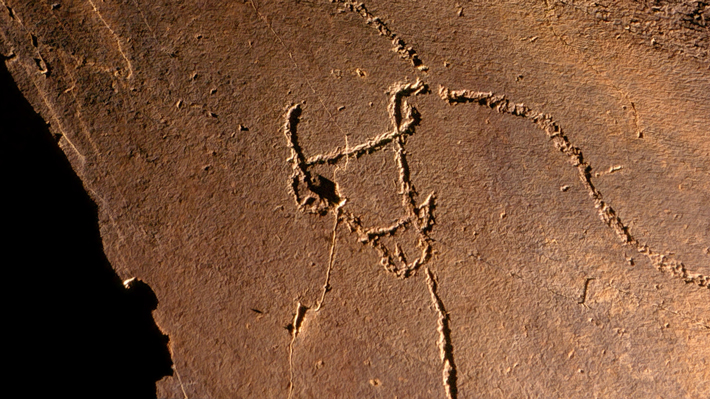 While you’re there
While you’re there
The Côa Valley is in Douro wine country, which produces both table wine and port dessert wine. The Quinta da Ervamoira vineyard is within the boundaries of the archaeological park and houses a museum of the region’s history. Zilhão also recommends a visit to the nearby historical village of Marialva, once a military stronghold that received the charter of the first king of Portugal, Afonso I. Of the picturesque walled village, Portuguese novelist José Saramago writes, “It is this complex of ruined buildings, and the mystery that unites them, the present memory of all those who lived here, that suddenly moves the traveler, brings a lump to his throat and tears to his eyes.”
Advertisement
Advertisement
IN THIS ISSUE
Features
Öland, Sweden. Spring, A.D. 480
France’s Roman Heritage
Recovering Hidden Texts
Letter from Guatemala
From the Trenches
Legends of Glastonbury Abbey
Off the Grid
A Circle of Skulls
Medieval Russian Memo
The Ring’s the Thing
Chinatown before the Quake
Tomb from a Lost Tribe
Alfred the Great’s Forgotten Ally
Reading an Inca Archive
Minding the Beeswax
Quarrying Stonehenge
A Viral Fingerprint
Caesar’s Diplomatic Breakdown
Ship Underground
Advertisement

Recent Issues
-
 May/June 2024
May/June 2024
-
 March/April 2024
March/April 2024
-
 January/February 2024
January/February 2024
-
 November/December 2023
November/December 2023
-
 September/October 2023
September/October 2023
-
 July/August 2023
July/August 2023
-
 May/June 2023
May/June 2023
-
 March/April 2023
March/April 2023
-
 January/February 2023
January/February 2023
-
 November/December 2022
November/December 2022
-
 September/October 2022
September/October 2022
-
 July/August 2022
July/August 2022
-
 May/June 2022
May/June 2022
-
 March/April 2022
March/April 2022
-
 January/February 2022
January/February 2022
-
 November/December 2021
November/December 2021
-
 September/October 2021
September/October 2021
-
 July/August 2021
July/August 2021
-
 May/June 2021
May/June 2021
-
 March/April 2021
March/April 2021
-
 January/February 2021
January/February 2021
-
 November/December 2020
November/December 2020
-
 September/October 2020
September/October 2020
-
 July/August 2020
July/August 2020
-
 May/June 2020
May/June 2020
-
 March/April 2020
March/April 2020
-
 January/February 2020
January/February 2020
-
 November/December 2019
November/December 2019
-
 September/October 2019
September/October 2019
-
 July/August 2019
July/August 2019
-
 May/June 2019
May/June 2019
-
 March/April 2019
March/April 2019
-
 January/February 2019
January/February 2019
-
 November/December 2018
November/December 2018
-
 September/October 2018
September/October 2018
-
 July/August 2018
July/August 2018
-
 May/June 2018
May/June 2018
-
 March/April 2018
March/April 2018
-
 January/February 2018
January/February 2018
-
 November/December 2017
November/December 2017
-
 September/October 2017
September/October 2017
-
 July/August 2017
July/August 2017
-
 May/June 2017
May/June 2017
-
 March/April 2017
March/April 2017
-
 January/February 2017
January/February 2017
-
 November/December 2016
November/December 2016
-
 September/October 2016
September/October 2016
-
 July/August 2016
July/August 2016
-
 May/June 2016
May/June 2016
-
 March/April 2016
March/April 2016
-
 January/February 2016
January/February 2016
-
 November/December 2015
November/December 2015
-
 September/October 2015
September/October 2015
-
 July/August 2015
July/August 2015
-
 May/June 2015
May/June 2015
-
 March/April 2015
March/April 2015
-
 January/February 2015
January/February 2015
-
 November/December 2014
November/December 2014
-
 September/October 2014
September/October 2014
-
 July/August 2014
July/August 2014
-
 May/June 2014
May/June 2014
-
 March/April 2014
March/April 2014
-
 January/February 2014
January/February 2014
-
 November/December 2013
November/December 2013
-
 September/October 2013
September/October 2013
-
 July/August 2013
July/August 2013
-
 May/June 2013
May/June 2013
-
 March/April 2013
March/April 2013
-
 January/February 2013
January/February 2013
-
 November/December 2012
November/December 2012
-
 September/October 2012
September/October 2012
-
 July/August 2012
July/August 2012
-
 May/June 2012
May/June 2012
-
 March/April 2012
March/April 2012
-
 January/February 2012
January/February 2012
-
 November/December 2011
November/December 2011
-
 September/October 2011
September/October 2011
-
 July/August 2011
July/August 2011
-
 May/June 2011
May/June 2011
-
 March/April 2011
March/April 2011
-
 January/February 2011
January/February 2011
Advertisement






